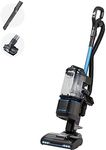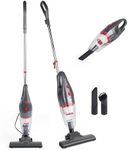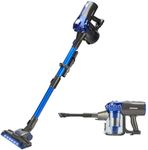Buying Guide for the Best Vacuum Cleaners Uprights
Choosing the right upright vacuum cleaner can make a significant difference in maintaining a clean and healthy home. Upright vacuum cleaners are popular for their powerful suction and ease of use, especially on carpets. When selecting the best model for your needs, it's important to consider several key specifications that will impact the vacuum's performance and suitability for your home. Understanding these specs will help you make an informed decision and ensure you get the best fit for your cleaning requirements.Suction PowerSuction power is a measure of how effectively the vacuum can pick up dirt and debris. This is important because stronger suction means better cleaning performance, especially on carpets and rugs. Suction power is often measured in watts or air watts. Higher values indicate more powerful suction, but for most homes, a mid-range power level is sufficient. If you have thick carpets or pets, you might want to opt for a higher suction power to ensure thorough cleaning.
Filtration SystemThe filtration system in a vacuum cleaner determines how well it can trap dust, allergens, and other particles. This is crucial for maintaining indoor air quality, especially if you have allergies or asthma. HEPA (High-Efficiency Particulate Air) filters are the gold standard, capturing 99.97% of particles as small as 0.3 microns. If air quality is a concern, look for vacuums with HEPA filters. For general use, a standard multi-layer filtration system may suffice.
Weight and ManeuverabilityWeight and maneuverability affect how easy the vacuum is to use, especially if you have a multi-story home or need to carry it up and down stairs. Lighter vacuums are easier to handle and maneuver around furniture. If you have a large home or physical limitations, consider a model that balances weight and power. Some vacuums come with swivel steering, making them easier to navigate around obstacles.
Bagged vs. BaglessUpright vacuums come in both bagged and bagless designs. Bagged vacuums use disposable bags to collect dirt, which can be more hygienic and easier to dispose of without releasing dust back into the air. Bagless vacuums use a dustbin that you empty directly, which can save money on bags but may require more frequent maintenance. Choose bagged if you prefer less contact with dust, and bagless if you want to avoid the ongoing cost of replacement bags.
Cord Length and Cordless OptionsCord length determines how far you can move the vacuum without needing to switch outlets. Longer cords are beneficial for larger rooms or homes. Cordless vacuums offer greater mobility and convenience, especially for quick clean-ups, but they rely on battery life, which can limit usage time. If you have a large area to clean, a longer cord or a high-capacity battery in a cordless model will be more practical.
Attachments and AccessoriesAttachments and accessories enhance the versatility of your vacuum cleaner. Common attachments include crevice tools, dusting brushes, and upholstery tools. These are useful for cleaning different surfaces and hard-to-reach areas. Consider what types of surfaces and spaces you need to clean. If you have pets, look for models with pet-specific tools designed to remove pet hair from furniture and carpets.
Noise LevelNoise level is an important consideration if you are sensitive to loud sounds or have young children or pets. Vacuum noise is measured in decibels (dB). Quieter models typically operate around 60-65 dB, while more powerful models can be louder. If noise is a concern, look for vacuums that are specifically designed to operate quietly without compromising on performance.

















